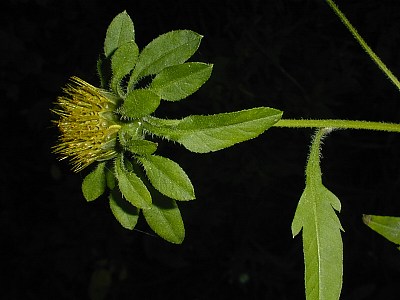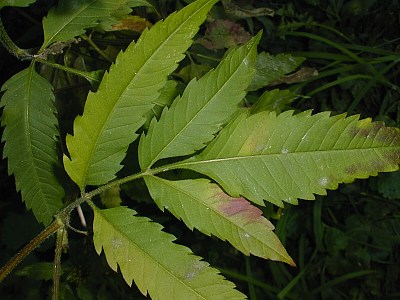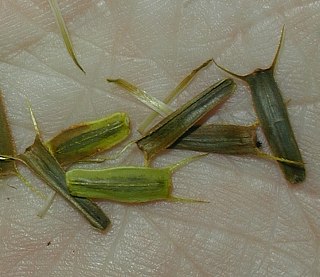Description: This annual plant is about 2–3½' tall, branching occasionally. The stems are light green, reddish green, or brown; they are often ribbed and slightly to moderately hairy. The opposite compound leaves are simple-pinnate, becoming smaller as they ascend the stems. These compound leaves are up to 10" long and 6" across; they consist of 3-5 leaflets and have petioles up to 2" long. The leaflets are up to 3" long and 1" across; they are lanceolate or narrowly ovate, coarsely toothed along the margins, and hairless. These leaflets have short petioles (petiolules) or they are sessile. In addition to the opposite compound leaves, some of the upper leaves may be alternate and simple.

The upper stems
terminate in a single flowerhead on a long slender stalk (peduncle).
This flowering stalk is more or less hairy and may have 1 or 2 simple
leaves up to 1½" long. The flowerhead is about ¾–1" across and it is
subtended by 11-20 leafy bracts. These bracts are oblanceolate to
linear in shape and ciliate along their margins. The flowerhead
contains several tiny florets that are tightly bunched together. Each
yellow disk floret is tubular in shape with 5 tiny teeth along its
upper rim. The ray florets are insignificant. The blooming period
occurs from late summer to fall and lasts about 1-2 months. There is no
noticeable floral scent. The florets are replaced by achenes up to ¼"
long. These achenes are initially yellow-green in color, but they
eventually become dark brown. Each achene is oblong and flattened; it
is a little broader toward the top than the bottom. At the apex of each
achene, there is a pair of slender barbed awns. The root system is
strongly branched and rather shallow. This plant reproduces by its
achenes only.
Cultivation:
The preference is full sun to light shade, wet to moist conditions, and
a loamy or silty soil. Soil fertility and moisture availability can
significantly influence the size of individual plants. Occasionally,
the leaves are disfigured by various kinds of disease later in the year.

Range &
Habitat:
The native Tall Beggar's Ticks is an occasional plant that occurs in
most areas
of Illinois; it is uncommon or absent in the southwestern and
north-central
areas of the state (see Distribution
Map). Habitats include openings in moist woodlands, woodland
borders, areas adjacent to woodland paths, thickets and meadows in
floodplain areas, marshes and seasonal wetlands, drainage ditches, and
waste areas. Tall Beggar's Ticks is found in wooded areas to a greater
extent than other Bidens spp., although it also
occurs in sunny wetlands. Disturbed areas are strongly preferred; this
species is rather weedy.
Faunal Associations:
The flowers aren't very showy and attract few insect visitors.
Occasionally, various bees and flies suck nectar from the disk florets.
Pollen may be an occasional source of food for some of these insects.
The caterpillars of the butterfly Nathalis iole
(Dainty Sulfur) feed on the foliage of Bidens spp.,
as do the caterpillars of several moth species, including Cirrhophanus
triangulifer (Goldenrod Stowaway), Epiblema otiosa
(Bidens Borer
Moth), Condica confederata (The Confederate), Palthis
asopialis (Faint-Spotted Palthis), and Platysenta
mobilis (Mobile
Groundling). Various birds eat the seeds of Bidens spp.
to a limited extent, including the Mallard, Ring-Necked Pheasant,
Bobwhite Quail, Purple Finch, Common Redpoll, and Swamp Sparrow. The
Cottontail Rabbit eats the foliage of Bidens spp.
to a limited extent. The barbed achenes cling readily to the fur of
mammals and the clothing of humans, which helps to distribute them into
new areas.

Photographic
Location:
A roadside ditch along a wooded area near Judge Webber Park in Urbana,
Illinois.
Comments:
Tall Beggar's Ticks is often confused with Bidens frondosa
(Common Beggar's Ticks) because of their similar appearance. Both
species have non-showy flowerheads and they have compound leaves that
are simple-pinnate. However, Tall Beggar's Ticks has 11-20 leafy bracts
that surround each flowerhead, while Common Beggar's Ticks has only
7-10 leafy bracts per flowerhead. It is easy to see that the flowerhead
in the upper photograph has more than 10 leafy bracts. Another species,
Bidens discoidea, has even fewer leafy bracts than
Common Beggar's Ticks. The barbed achenes of Tall Beggar's Ticks are
very similar in appearance to those of Common Beggar's Ticks, although
they are slightly larger in size. Other Bidens spp.
in Illinois differ from the preceding species because they have showy
flowerheads with conspicuous ray florets, and/or they have either
simple leaves or compound leaves that
are double-pinnate. Notwithstanding its common name,
Tall Beggar's Ticks isn't substantially taller than Common Beggar's
Ticks and many other Bidens spp.